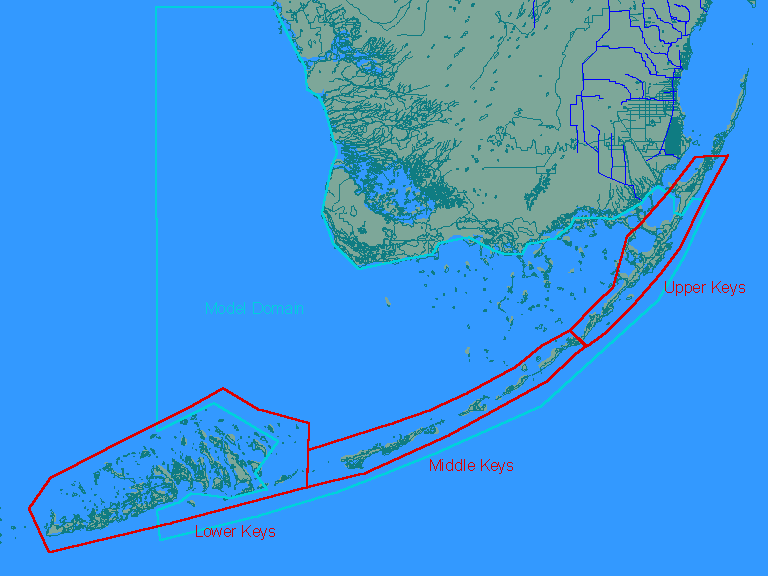Estimation of Inputs to
Florida Bay
Inputs from Florida Keys - WastewaterJuly 1998 Project Index | Provide Comments Introduction | Methods | Results | Potential Refinements This section develops estimates of flows and nutrient loads in wastewater discharges from the Florida Keys. The methodology and assumptions are derived primarily from the draft Water Quality Protection Program for the Florida Keys National Marine Sanctuary (USEPA, 1992,1993; Kruczynski, 1998). Based upon source inventories in the above references, estimates are derived for three regions (Upper, Middle, and Lower Keys), as shown below:
Runoff flows and loads are also summarized for these regions. Most of the Lower Keys region is outside of the model domain. The major surface wastewater discharge from the Keys is from the City of Key West. This discharge is assumed to occur outside of the model domain and is therefore ignored in the load estimates. Estimates of other discharges from the Lower Keys are provided, but may not be relevant to the modeling effort. Flow and load estimates are derived for wastewaters in the following categories:
The following equations are used to estimate wastewater volumes and loads from each region and category:
where,
Wastewater volumes are estimated based upon reported flows or numbers of source units (septic tanks, cesspits, boats). Seasonal scale factors are applied to estimated wastewater volumes to account for seasonal variations in population. Wastewater volumes are multiplied by assumed concentrations in each wastewater category to estimate source loads. Several inconsistencies were found in reviewing the derivation of wastewater loads (USEPA, 1992). Not all of these inconsistencies have been resolved. The numbers of septic tanks and cesspits reported by USEPA (1992) have been revised downward (to ~60% of reported values) so that estimates of phosphorus loads from these wastewater types approximately equal those reported by Kruczynski (1998). For wastewater discharges to groundwater, factors to account for attenuation of loads between points of discharge and points of inflow to the Bay or Reef are included in the estimation procedure. Losses would reflect interactions with soils and limestone. Nominal losses of 50% are assumed for phosphorus, nitrogen, and suspended solids. While estimation of transport losses is difficult, ignoring them altogether would over-estimate loads reaching the bay or reef. Partitioning of nutrient species and estimates of other water quality components are derived using a framework which is similar to that used in estimating loads from the Florida mainland and runoff loads from the Keys. Finally, coefficients to reflect the destination of wastewater loads (bay vs. reef) are included; current estimates assume that 100% of the MWWTP surface discharges are to the reef, 20% of the boat discharges are to the reef, and 50% for the other wastewater types. Additional research would be needed to refine these assumed spatial distributions. Output files are generated on a monthly basis between October 1985 and December 1997. Results vary with season, but are constant with year. Input values and results are listed in the attached tables:
The output file contains a monthly average flow (m3/sec) and flow-weighted-mean concentration (ppm) for each water-quality component, for each month between October 1985 and December 1997, and for 6 inflow points (discharges to bay & reef from 3 areas).. An excel workbook will be provided to generate output files for alternative sets of assumptions. The following tasks would provide refined estimates of wastewater volumes and loads from the Keys:
Such efforts may be justified if the Bay water quality model is found to be sensitive to wastewater loads. http://www.wwwalker.net/flabay/keys_ww.htm Updated: 03/30/02 |
